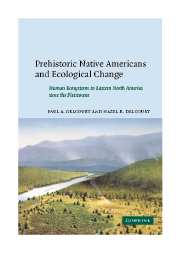 Prehistoric Native Americans and Ecological Change
Prehistoric Native Americans and Ecological Change Book contents
- Frontmatter
- Contents
- Acknowledgements
- PART I PANARCHY AS AN INTEGRATIVE PARADIGM
- PART II ECOLOGICAL FEEDBACKS AND PROCESSES
- 4 Gene-level interactions
- 5 Population-level interactions
- 6 Community-level interactions
- 7 Landscape-level interactions
- 8 Regional-level interactions
- PART III APPLICATION AND SYNTHESIS
- References
- Index
7 - Landscape-level interactions
Published online by Cambridge University Press: 30 October 2009
- Frontmatter
- Contents
- Acknowledgements
- PART I PANARCHY AS AN INTEGRATIVE PARADIGM
- PART II ECOLOGICAL FEEDBACKS AND PROCESSES
- 4 Gene-level interactions
- 5 Population-level interactions
- 6 Community-level interactions
- 7 Landscape-level interactions
- 8 Regional-level interactions
- PART III APPLICATION AND SYNTHESIS
- References
- Index
Summary
ANTHROPOGENIC DISTURBANCE, FOREST FRAGMENTATION, AND LANDSCAPE STABILITY
Along the continuum from incipient domestication of plants, to slash-and-burn cultivation of village garden plots, to development of extensive agricultural fields, several kinds of landscape thresholds may be crossed. These thresholds involve geomorphic processes, hydrologic changes, and habitat continuity. Anthropogenic disturbance, if severe and extensive enough, can result in over-exploitation of resources leading to forest fragmentation, soil degradation, and deterioration of the environment, with potentially irreversible effects (Figure 3.4). According to Redman (1999, p. xi): “The archaeological record is populated with thousands of communities [worldwide] that for varying lengths of time maintained a balance with their environment, yet over time, virtually all developed practices that degraded their surroundings and undermined their continued existence.”
Native American disturbance and landscape change: Crawford Lake, Ontario
High-resolution pollen, plant macrofossil, and charcoal records from southern Ontario give definitive evidence that Native Americans impacted the vegetation during the time interval from 650 to 250 BP, before the, time of European American settlement of the region (McAndrews and Boyko-Diakonow, 1989; Byrne and Finlayson, 1998). The evidence is derived from annually laminated sediments from Crawford Lake, located 65 km southwest of Toronto, along the Niagara Escarpment, within the northern conifer–mixed hardwoods forest region (Figure 7.1).
Because the Crawford Lake basin is relatively small (2.4 ha surface area), deep (24 m water depth), and steep-sided, the lake is meromictic and has deposited sediments in annual varves.
- Type
- Chapter
- Information
- Prehistoric Native Americans and Ecological ChangeHuman Ecosystems in Eastern North America since the Pleistocene, pp. 90 - 133Publisher: Cambridge University PressPrint publication year: 2004


